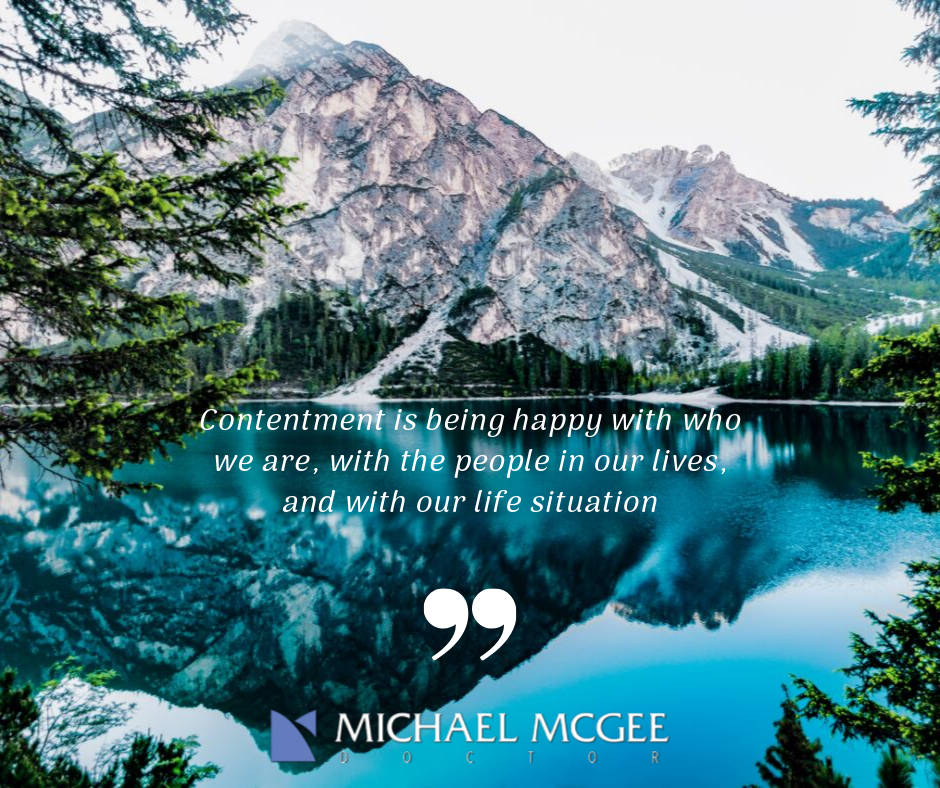What is contentment?

One of the love practices is the practice of contentment. Contentment is being happy with who we are, with the people in our lives, and with our life situation. It is a practice of reverence for the reality of this moment just as it is, reverence for who we are just as we are, and reverence for others just as they are. When we are content, this moment is more than enough, and enough is an abundant feast.
The benefits of contentment
There is a paradox about contentment, because contentment gives us the peace of mind and the positivity needed to heal, to grow, and to improve our life situation. Content people are not complacent. They still have drives and aspirations. Content people still want to make the world a better place. We can be happy with this day and still dream of a better tomorrow. If you’d like to heal and grow, start with contentment. If you’d like your life to improve, start with contentment. If you’d like to help others to heal and grow, start with contentment—an acceptant appreciation of others just as they are.
Contentment is good for us. Contentment fuels happiness, because we can let go of painful cravings for what we do not have and for things to be different from how they are. Contentment promotes acceptance. Contentment is the antidote for the poisons of discontent, envy, and jealousy. Contentment enables us to savor this wonderful gift of existence without a need for more or different. Contentment allows us to enjoy and appreciate our lives just as they are.
Contentment is also good for our relationships. Contentment helps us to enjoy our family and friends. Contentment makes us more acceptant and appreciative of others. Contentment allows us to love others just for who they are. Contentment thus enriches our relationships. People feel the safety and security of our contentment, and respond with appreciation and trust. This fosters their growth and healing.
When we are content, we don’t need more than we need. Contentment is the antidote to endless wanting and to addictive craving. The abundance of the Now is more than enough. With contentment, we can distinguish wantsfrom needsand let unnecessary wants go. Contentment helps us see that joy does not come from our possessions or even our life situation.
Contentment promotes simplicity, which reduces stress. When we can let go of unnecessary wants, we avoid burdening our lives with the complications of excessive consumption, in which our possessions begin to own us rather than the other way around. We see that less is more, and that less is enough.
Cultivating Contentment.
- Savor Existence.The first practice for cultivating contentment is to simply stop and notice that we are alive and aware. How amazing, this gift of self-aware existence! This is something to be savored. How incredible to be reading these words! We have a remarkable capacity for taking the everyday miraculous for granted. This is a spiritual practice of being fully present to this eternal moment as the perpetual first, last, and only precious moment of existence. The practice of presence fosters de-habituation, or “un-getting-used-to-things.” We develop “Beginner’s Mind,” in which we savor existence freshly, moment-by-moment. We wake up to see that this moment is sacred. We see that the ordinary is truly extraordinary.
- Be Mindful of Impermanence. Keep in mind that this gift of existence will not last. None of us gets out of this alive. Life is resilient, yet fragile. And it is fleeting. We will all too soon be dead. Knowing this enhances our contentment because awareness of our mortality enhances the preciousness of this gift of life. Best that we savor this moment, even if it isn’t exactly to our liking. Similarly, be mindful of the impermanence of everything else. Only change is permanent. If we are in pain, we can take heart that this pain will end. If we are joyful, we savor our joy even more, knowing that our joy will pass, and that pain, loss, and grief lie ahead.
- Practice Gratitude.The third practice is the practice of gratitude, in which we mindfully count our blessings, starting with the miraculous gift of our existence. Even amid pain, grief, and loss, gratitude helps us to see that our glass of life is usually 90% full. With the practice of gratitude, we can have gratitude even during the direst of times, when our glass is truly only 10% full. Reflect on the faculties you have. Reflect on the millions of people who have contributed in some way over your lifetime to sustain you. Reflect on the generous, intelligent abundance of nature that sustains us all. Reflect on the reality of grace and healing. With gratitude, we focus on what we have rather than what we do not have. When we are grateful for the abundance of our lives, we can be happy for others without needing to compare our lives to theirs. Gratitude helps to counter envy and jealousy.
- See that Less is More.The fourth practice is seeing clearly that, after meeting basic sustenance and comfort needs, happiness does not come from possessions, power, prestige, or status. We need only consider the suicides of incredibly successful and gifted people to see the truth of this. One of the happiest people I have known was an impoverished food service worker. Seeing that happiness is largely dependent on our state of mind rather than our state of affairs also counters envy and jealousy. Cultivate contentment by letting go of the illusion that wealth, fame, status, or prestige bring happiness. “More” does not bring more happiness.
- Practice Abstinence.The fifth practice is the practice of abstinence. We cultivate contentment by abstaining from something we usually enjoy, such as food, work, sex, alcohol, TV, or social media. Religions over the ages have encouraged the cultivation of contentment through fasting rituals. Examples include Yom Kippur, Ramadan, and Lent. Abstinence is central to the process of recovery, in which we abstain from acting on destructive cravings out of love for ourselves and others. One craving management practice is to intentionally smile at our destructive compulsions and cravings, saying to ourselves, “This is the feeling of healing.” We remind ourselves that not acting on destructive cravings enhances our lives. Through abstaining, we learn to live with and resolve our cravings through the various love-based practices. The practice of abstinence gives us the opportunity to practice being content while going without something we want and enjoy. This is a practice of letting desire be, without compulsively acting on the urgings of desire. We just let desire be. And in the letting be, contentment arises, even amid desire. This is an incredibly freeing experience; it frees us to do the right thing—to act with love—even during urges to do otherwise.
- Renounce and Rejoice. A sixth practice, closely related to the practice of abstinence, is the practice of renunciation. What do we renounce? We renounce gratification as a source of happiness, whether it be through sensual pleasures or the acquisition of possessions. It’s fine to enjoy these things; we just need to see gratification for what it is—just gratification—and not confuse it with true happiness. True happiness arises through the practice of love, not the gratification of desires.
Cultivating contentment takes the suffering out of distress. Distress is inevitable, but suffering is optional. Without the suffering of compulsive desires, we are free to act with love to enhance both our lives and the lives of others. When you find yourself experiencing discontent, envy, or jealously, practice these contentment practices to cultivate your contentment. You and everyone around you will be the better for it.

A version of this article was published in Recovery Today Magazine issue 56, July 2019 www.recoverytodaymagazine.com >> see the article here on pages 15-16
